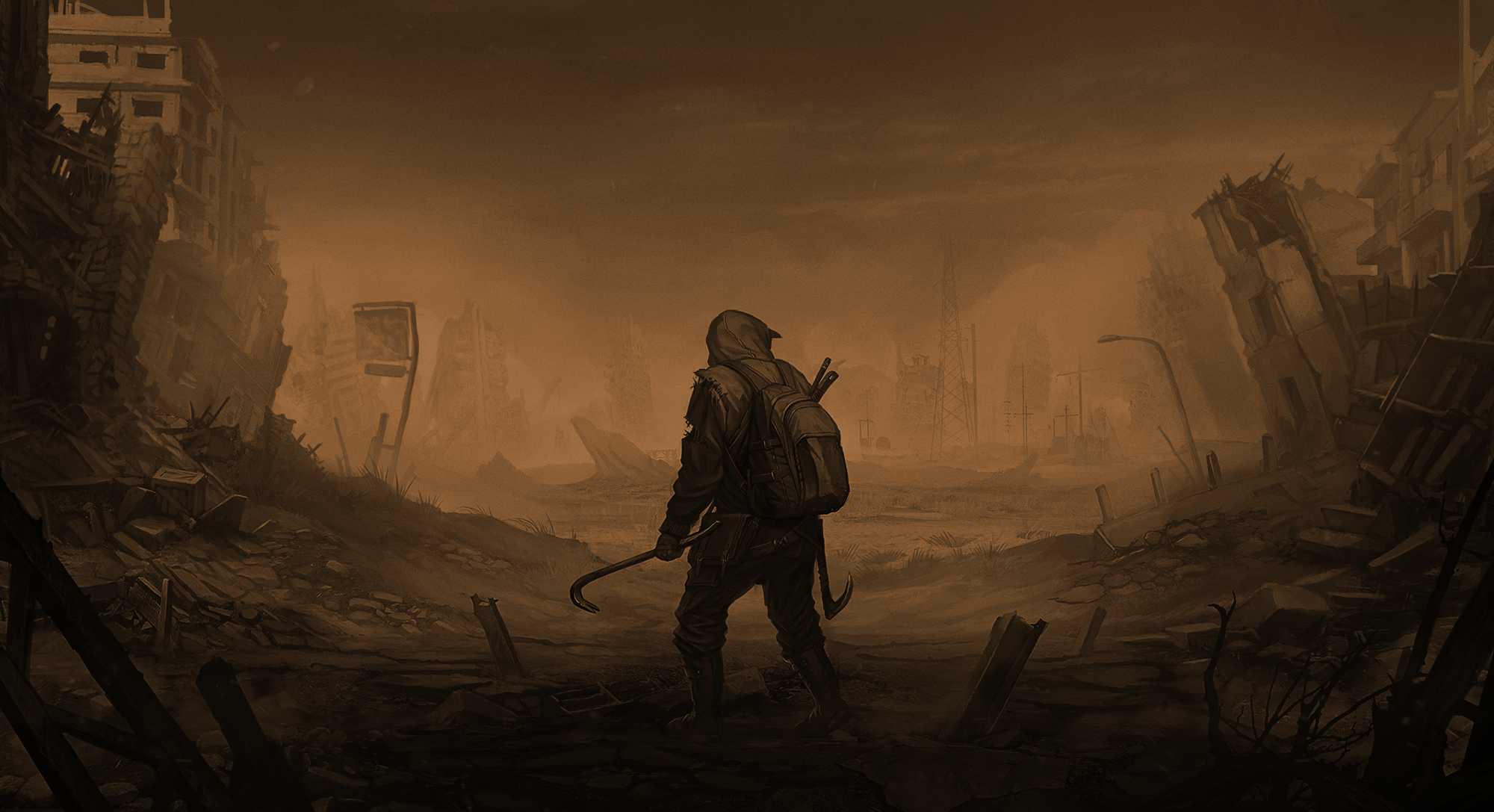Through the history of the Morrow project the Supply cache has been a vague thing. A small concrete bunker or something else buried full of goodies. Thinking about the idea and what is available I do not think that the Morrow project would use custom made structures for supply caches. Imagine the amount of work to make tens of thousands of supply caches with 3-8 of them per team buried. The caches needed to be something buried under secrecy and that means doing it quickly. Quickly means prefabs that can be trucked in and put in the ground within a day or two. That is why I feel that the project would use precast vaults and standard shipping containers that had reinforcements added to them on the inside. This would create cache modules of many sizes that will look completely inconspicuous while being transported to cache sites. Which would be if incredible importance to the project during the deployment phase.
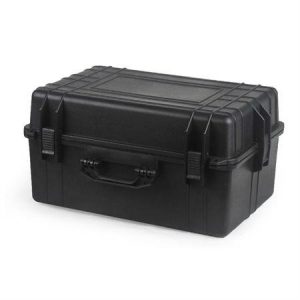
The contents of the caches I also believe would be not just stacked in wooden or cardboard boxes, but instead all placed inside of tactical style cases. These cases are made from several companies and are heavy plastic with water and air seals that latch tightly. the contents inside would benefit from additional protection in case the outer cache was compromised. The importance of each teams mission means that their caches are vitally important to them and the success of their mission.The use of plastic cases inside the caches as a last line of defense to make sure that the contents are safe for the teams would be a minor expense to the project. Each case would have a dessicant bag and a oxygen scavenging bag placed inside before closing. Plus the cases would be beneficial to the team or the community as well. these cases could be used for storage or even modified into water filtration system (sand bed filter) and other uses. Every item inside the cache will be reuseable, even the dessacant can be dried out in a makeshift oven for re-use. Nothing inside the cache has any Morrow branding or logos. no cases are labeled as to the contents.
The Standard Cache
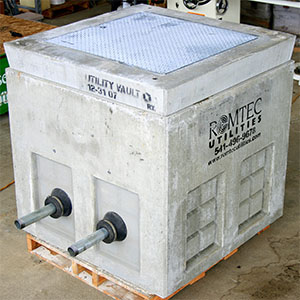
For the smaller caches, precast vaults for telecommunications would be used, these are cheap compared to anything custom and easily upgraded for long term storage. On the outside they will look like common every day telecom items and not attract any attention when deployed. They would be assembled and stocked inside a factory and shipped out for rapid burial. These vaults would be ordered reinforced and cast thicker than normal, coated with a thick epoxy sealant to reduce water ingress as well as have the contents inside a hermetically sealed thin 250mil thick plastic internal tub. the tub would internally have desiccant and a nitrogen purge canister that tries to maintain a 1psi pressure differential to reduce any water ingress in case of a leak. Dessicant and oxygen scavenging products would be put inside as well. No powered unlocking systems exist on these caches, just a simple 5 point security bolt head that keeps the top cover secured about 16 to 32 stainless bolts are used that are also recessed then soft mortared over, teams would know to start prodding with a screwdriver to find the bolt head plugs plus the cache opening kit would have a booklet with the special wrench. This type would cover the smaller caches that are no larger than 8-10 feet in size and are typically used for recon and emergency caches. the vaults may or may not have a decoy metal cover and decoy fake pipes entering the cache to help disguise it. This would be the most common type of supply cache found for most teams. Science and MARS teams may have one or two very large caches. If a person did not have the tools to open it, it would take a very very long time with sledgehammers to gain access to the inside.
Very Large Caches
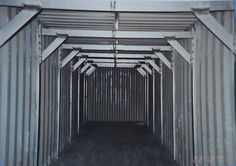 The amount of equipment you can fit in the common 20 foot long reinforced shipping container cache is quite a bit even after all the heavy duty internal reinforcing to withstand being buried, so we can add some embellishments to make it easier for the team to extract the contents by adding a ladder and a opening that goes to the bottom. That single 20 foot long cache can be buried horizontally or vertically depending on what is needed. Vertically reduces the footprint of disturbed soil and makes it harder to detect that something BIG was just buried and eliminated the need to heavily reinforce the ceiling in case someone parks a large vehicle on top. Traditionally the caches also have an access mechanism that uses the project ID cards. This means power and a handwave is used to say it just works. With my design, the team when they uncover the opening will find a panel they have to connect the vehicle to that will supply power to the cache, now they can activate the locking mech and start the process of opening it. But what about the contents? to make sure it will stay “fresh” I am sure there would be a tank of compressed nitrogen in each cache. When commissioned, the last thing done before sealing up is activating the nitrogen purge and pushing out all air. Seal it up and the system uses a simple mechanical regulator to keep the inside of the cache at 1-2 psi higher than normal to keep out any water ingress as well as maintain the zero oxygen environment. Along with oxygen scavengers and moisture scavenger bags this system based on existing technology used for underground tech vaults and underwater cables would ensure that the contents of each cache be as fresh as the day they were sealed.
The amount of equipment you can fit in the common 20 foot long reinforced shipping container cache is quite a bit even after all the heavy duty internal reinforcing to withstand being buried, so we can add some embellishments to make it easier for the team to extract the contents by adding a ladder and a opening that goes to the bottom. That single 20 foot long cache can be buried horizontally or vertically depending on what is needed. Vertically reduces the footprint of disturbed soil and makes it harder to detect that something BIG was just buried and eliminated the need to heavily reinforce the ceiling in case someone parks a large vehicle on top. Traditionally the caches also have an access mechanism that uses the project ID cards. This means power and a handwave is used to say it just works. With my design, the team when they uncover the opening will find a panel they have to connect the vehicle to that will supply power to the cache, now they can activate the locking mech and start the process of opening it. But what about the contents? to make sure it will stay “fresh” I am sure there would be a tank of compressed nitrogen in each cache. When commissioned, the last thing done before sealing up is activating the nitrogen purge and pushing out all air. Seal it up and the system uses a simple mechanical regulator to keep the inside of the cache at 1-2 psi higher than normal to keep out any water ingress as well as maintain the zero oxygen environment. Along with oxygen scavengers and moisture scavenger bags this system based on existing technology used for underground tech vaults and underwater cables would ensure that the contents of each cache be as fresh as the day they were sealed.
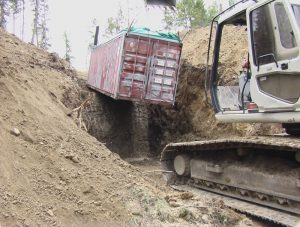
The whole cache build and filling process would be done at a factory, then the containers placed on semi trucks and shipped to the construction sites that have been digging the holes. the trucks arrive at night, they drop it in the hole, check integrity of the seal and purge then bury it by morning. the process would be rapid, efficient, and lower installation costs. But the design does add some wrinkles to the teams opening the caches.
First they have to power the cache to open it, if they lose the vehicle they lose their biggest power source, so hopefully they still have a solar panel or two. secondly they will have to “air out” the caches before entering. Any team member just jumping in after opening will die of suffocation. part of the power hook up will start bilge vent fans that are ducted to the bottom and exhaust out the entry hole to purge the atmosphere and make it breathable, the panel would have a green indicator light when the oxygen sensor at the bottom detects oxygen at a safe level. The power would also light up the LED lighting inside that will allow them to work without flashlights. The power would also disable the nitrogen purge canister if there was anything left in it. The panel would upon powering up show cache status as well as other information after the keycard was inserted. they would have to flip the “open” switch to open it. That way teams can find a cache and check it’s integrity without opening it. The construction teams would do the same thing when burying it.
Could the team seal one back up? yes. but it will not be sealed like before as you can’t purge it and the door seal will not be hermetic or 100% air and waterproof anymore after opening.
Larger caches or different types with hydraulic systems to lift a trailer out for the team would exist. but still follow a standard form factor. For example a 20 foot unit with a trailer inside would have a lift platform in the bottom 10 feet and the trailer on the top 10 disassembled. the team would power the cache to lift the trailer slowly, then have to put on the wheels and tongue to tow it away. A huge cache with another vehicle would have to be buried in a way that the vehicle can be retrieved easily and would be a custom cache.
Cache Contents
There is a lot of discussion on cache contents, Current 4.0 rules still talk about the older Stoner weapons systems, and for teams frozen early, they would absolutely have those. But what about a team frozen today?
M16A4 is the current US military weapon platform and works well. Despite the claims it’s finicky they do in fact work decently even when dirty. I personally have fired 900 rounds off and on through an AR-15 civilian variant without cleaning it and have had no real problems. Browning 9mm pistols also have a fantastic reliability when not cleaned for weeks. there is a reason the military chose them. Because our warriors in the field do not have the ability to strip down and clean their rifle every 100 rounds, in heavy combat it may be days and 3000 rounds later before a soldier is able to take the time to tear down and clean their rifle. Along with this the 5.56 round is the single most common round out there in the USA right now.
Weapon Choices are the PD’s prerogative. choose what you want for your teams. but dont be afraid of upgrading or changing. I am actually looking at arming teams with the FN57 pistol and P90 weapon systems as these are fantastic weapons that are perfect for small quarters combat and a pistol that can hold 30 rounds and can fire armor piercing is a game changer for the person relying on it. That said, below is an example of my standard cache contents that a team would get. Science and MARS would have different specialized caches and if you as the PD are feeling nice, give them a cache with a spare vehicle in it.
3 - Project personal climate kit for the area deployed. (cold climate, hot climate, wet climate, etc)
2 - Project Survival Gear sets with bivvy tents/hammock tents and sleeping and backpack system.
1 - Project Climbing gear sets
2 - Rifle parts kits with tools and 8 spare magazines
2 - universal weapon cleaning and servicing kits
2 - Pistol repair kits with tools and 8 spare magazines
1 - pump action 12ga shotgun with sling
3 - pair Project boots team sizes
1 - Case of 1000 rounds of 9MM ball ammo
1 - Case of 1000 rounds of loose 5.56 ball ammo
1 - Case of 250 rounds of 12 gauge Magnum buckshot loose
2 - replacement personal Project radios with headsets and accessories
2 - Project radio batteries.
1 - Grenade case with the following
6 CS Gas grenades
6 White smoke grenades
6 fragmentation grenades
2 thermite grenades
8 mixed red,white,green star shells and parachute flares 40mm grenades
8 CS gas 40mm grenades
8 HEDP 40mm grenades
2 - case vehicle weapon ammunition
3 - Pair Oakley Ballistic dark smoke/black
3 - new BDU sets
3 - Personal underwear sets (socks, boxers, briefs, undershirts, long underwear)
3 - knit black/od green reversible watch caps
3 - OD green plain baseball caps
3 - Boonie hats with neck curtain, OD green
1 - folding Shovel
1 - Long handle Axe with hammer head.
1 - folding pick
1 - vehicle Water filtration service kit
1 - vehicle air scrubber service kit
1 - vehicle Replacement wheel and tire
1 - vehicle replacement Axle
1 - vehicle lubrication and service kit
1 - vehicle antenna repair kit
1 - vehicle winch repair kit with new 100 foot stainless Cable with hook.
1 - “new car smell” small tree air freshener
10 - Small Cases of MRE’s 200 meals total
1 - vehicle contact kit replenish 8 total contact kits.
1 - case first air refill
1 - first aid advanced kit in a red pelican case
1 - recreational kit packed in a small pelican case that is yellow in color
2 decks of standard plain playing cards
4 sets of d6 dice
1 travel chess set
1 travel backgammon
2 sets of dominoes
4 small random fiction books
1 harmonica
